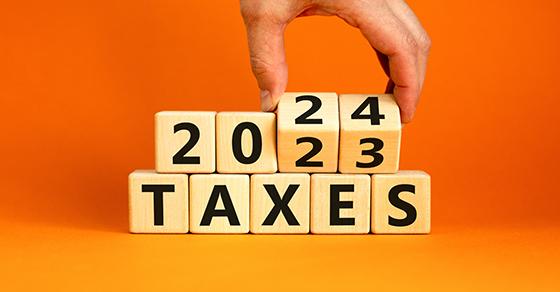The IRS recently announced various 2024 inflation-adjusted federal tax amounts that affect individual taxpayers.
Most of the federal income tax rate bracket thresholds are about 5.4% higher than for 2023. That means that you can generally have about 5.4% more income next year without owing more to the federal government.
Standard deduction
Here are the inflation-adjusted standard deduction numbers for 2024 for those who don’t itemize:
- $14,600 if you’re single or use married filing separate status (up from $13,850 in 2023).
- $29,200 if you’re married and file jointly (up from $27,700).
- $21,900 if you’re a head of household (up from $20,800).
Older taxpayers and those who are blind are entitled to additional standard deduction allowances. In 2024 for those age 65 or older or blind, the amounts will be: $1,550 for a married taxpayer (up from $1,500 in 2023) and $1,950 for a single filer or head of household (up from $1,850 for 2023).
For an individual who can be claimed as a dependent on another taxpayer’s return, the 2024 standard deduction will be the greater of: 1) $1,300 (up from $1,250 for 2023) or 2) $450 (up from $400 for 2023) plus the individual’s earned income, not to exceed $14,600 (up from $13,850 for 2023).
Ordinary income and short-term capital gains
Here are the 2024 inflation-adjusted bracket thresholds for ordinary income and net short-term capital gains:
- 10% tax bracket: $0 to $11,600 for singles, $0 to $23,200 for married joint filers, $0 to $16,550 for heads of household;
- Beginning of 12% bracket: $11,601 for singles, $23,201 for married joint filers, $16,551 for heads of household;
- Beginning of 22% bracket: $47,151 for singles, $94,301 for married joint filers, $63,101 for heads of household;
- Beginning of 24% bracket: $100,526 for singles, $201,051 for married joint filers, $100,501 for heads of household;
- Beginning of 32% bracket: $191,951 for singles, $383,901 for married joint filers, $191,951 for heads of household;
- Beginning of 35% bracket: $243,726 for singles, $487,451 for married joint filers and $243,701 for heads of household; and
- Beginning of 37% bracket: $609,351 for singles, $731,201 for married joint filers and $609,351 for heads of household.
Long-term capital gains and dividends
Here are the 2024 inflation-adjusted bracket thresholds for net long-term capital gains and qualified dividends:
- 0% tax bracket: $0 to $47,025 for singles, $0 to $94,050 for married joint filers, and $0 to $63,000 for heads of household;
- Beginning of 15% bracket: $47,026 for singles, $94,051 for married joint filers, and $63,001 for heads of household; and
- Beginning of 20% bracket: $518,901 for singles, $583,751 for married joint filers and $551,351 for heads of household.
Gift and estate tax
The annual exclusion for gifts made in 2024 will be $18,000 (up from $17,000 for 2023). That means you can give away up to $18,000 to as many individuals as you wish without incurring gift tax or using up any of your unified federal gift and estate tax exemption.
In 2024, the unified federal gift and estate tax exemption will be $13,610,000 (up from $12,920,000 for 2023).
For gifts made in 2024, the annual exclusion for gifts to a noncitizen spouse will be $185,000 (up from $175,000 in 2023).
Conclusion
This article only covers some of the inflation-adjusted tax amounts. There are others that may potentially apply, including: alternative minimum tax parameters, kiddie tax amounts, limits on the refundable amount of the Child Tax Credit, limits on the adoption credit, IRA contribution amounts, contributions to your company’s retirement plan and health savings account amounts. Various other inflation-adjusted amounts may affect your tax situation if you own an interest in a sole proprietorship or a pass-through business. Contact us with questions.
© 2023

